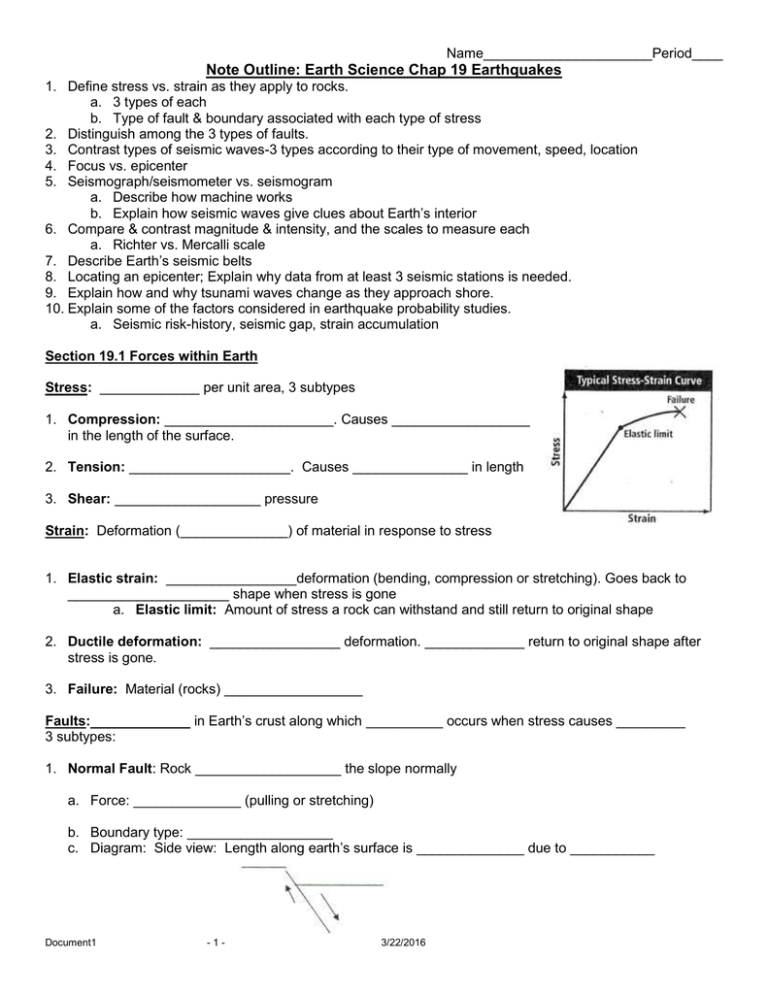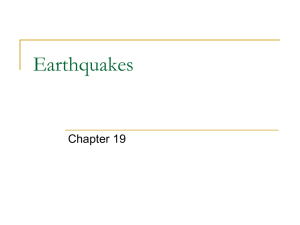Note Outline
advertisement

Name______________________Period____ Note Outline: Earth Science Chap 19 Earthquakes 1. Define stress vs. strain as they apply to rocks. a. 3 types of each b. Type of fault & boundary associated with each type of stress 2. Distinguish among the 3 types of faults. 3. Contrast types of seismic waves-3 types according to their type of movement, speed, location 4. Focus vs. epicenter 5. Seismograph/seismometer vs. seismogram a. Describe how machine works b. Explain how seismic waves give clues about Earth’s interior 6. Compare & contrast magnitude & intensity, and the scales to measure each a. Richter vs. Mercalli scale 7. Describe Earth’s seismic belts 8. Locating an epicenter; Explain why data from at least 3 seismic stations is needed. 9. Explain how and why tsunami waves change as they approach shore. 10. Explain some of the factors considered in earthquake probability studies. a. Seismic risk-history, seismic gap, strain accumulation Section 19.1 Forces within Earth Stress: _____________ per unit area, 3 subtypes 1. Compression: ______________________. Causes __________________ in the length of the surface. 2. Tension: _____________________. Causes _______________ in length 3. Shear: ___________________ pressure Strain: Deformation (______________) of material in response to stress 1. Elastic strain: _________________deformation (bending, compression or stretching). Goes back to _____________________ shape when stress is gone a. Elastic limit: Amount of stress a rock can withstand and still return to original shape 2. Ductile deformation: _________________ deformation. _____________ return to original shape after stress is gone. 3. Failure: Material (rocks) __________________ Faults:_____________ in Earth’s crust along which __________ occurs when stress causes _________ 3 subtypes: 1. Normal Fault: Rock ___________________ the slope normally a. Force: ______________ (pulling or stretching) b. Boundary type: ___________________ c. Diagram: Side view: Length along earth’s surface is ______________ due to ___________ Document1 -1- 3/22/2016 2. Reverse fault: Upper surface forced ______________ a. Force:________________ b. Boundary type: ________________ c. Diagram: Side view: Length along earth’s surface is ___________ due to compression 3. Strike-Slip Fault: Rocks ______________ each other wtihout upward or downward movement a. Force: ___________ b. Boundary type: _______________ c. Example: San ____________________ d. Diagram: Top view-streams, fence posts offset Earthquake Waves: Caused when the ___________ limit is reached and rocks fail or break. Due to pressure build-up when rocks ____________________. 3 subtypes 1. Primary Waves: Rock particles move back & forth in the _________ direction that the wave travels a. AKA P-wave: ______________ wave b. Location: ________________(________________-starts at focus) c. Can travel through ____________________, but slowed & bent in liquid d. ______________ wave. Arrives at seismograph station _______ e. Diagram: Document1 -2- 3/22/2016 2. Secondary Waves: Rock particles move at _________________ to the direction the wave travels a. AKA S-wave: ____________________ wave, underground b. Location: ________________(________________-starts at focus) c. Can ONLY travel through ______________. Therefore some seismograph stations don’t receive S waves. d. _____________________ speed wave e. Diagram: 3. Surface Waves: Rock particles move in _____________________ at once: backward, rolling motion & side to side swaying motion a. No nickname b. Location: ____________________ (Start at _________________, NOT focus) c. Causes most of the _________________ d. _____________________ wave e. Diagram: Focus: Point where earthquake _______________ & seismic waves ________________ Epicenter: Point on earth’s _______________ directly _______________ the focus. Section 19.2 Seismic Waves & Earth’s Interior 1. Seismology: Study of earthquake waves 2. Seismometer (AKA Seismograph): Instrument that detects & records seismic waves a. Rotating drum with paper & pendulum with pen attached. b. When seismic waves arrive, ____________ is shaken but the _________ stays stationary 3. Seismogram: Record on paper or in computer produced by a seismometer a. The farther apart in time that the ________________________ arrive, the farther the epicenter is from the seismograph station Document1 -3- 3/22/2016 Clues to Earth’s Interior When waves hit Earth’s core: 1. Shadow Zones: Areas of Earth that do not detect seismic waves because A. P-waves are refracted (___________) & ____________ by the liquid outer core B. S-waves do _______ enter the liquid core. They ________________ and are lost. 2. Wave speeds can be used to map Earth’s internal structure and determine: A. Whether it is ________________________ B. Determine the ________________________-iron vs. granite, etc. Earth’s interior: 1. Inner core: _________________, dense. Made mainly of ____________. 2. Outer core: _______________, mainly iron. 3. Mantle: a. _____________ layer of earth. b. Made of ______________________. c. Divided into upper & lower mantle based on different seismic wave speeds 4. Crust: Outermost layer. ________________ crust is _____________________ than oceanic crust. 5. Lithosphere plates: _____________ combination of ___________ & ____________ mantle Section 19.3 Measuring & Locating Earthquakes 1. Seismologist: Scientist who studies earthquakes 2. Magnitude: Amount of ___________________released during an earthquake. Based on: a. Richter scale: Measures (_________________) magnitude of an earthquake i. Based on size of the ______________ seismic waves on a seismogram ii. No upper limit iii. Most earthquakes are _________ to be _____ by humans (< 3.0) iv. Only ______ number on the Richter scale for each quake 3. Intensity: Amount of ______________ & ___________ damage a. Modified Mercalli Scale: Measures intensity in a _______________ location i. Roman numerals I to XII ii. I (low) is not felt vs. XII is total destruction iii. Damage is caused by _____________waves iv. _______________numbers for each quake, as different locations have different amounts of damage v. Dependent on: magnitude, depth of quake, type of rock or surface material, structure design & distance from epicenter. Document1 -4- 3/22/2016 Locating an Earthquake: 1. Epicentral distance = The distance between the seismic station and the __________________ 2. Must have a minimum of 3 seismic station readings to determine the epicenter location. Why? a. If there is only 1 station, the epicenter could be__________ on circle b. If there are 2 stations, the epicenter could be in _________ places c. If there are 3 stations, the epicenter could be in _________________ - where all three circles meet the 3. Most earthquakes occur in seismic belts along _____________________ Section 19.4 Earthquakes & Society Tsunami: Large _________________ wave created by vertical motion of ocean floor during a quake 1. 2. 3. 4. At sea, the wave is ________________ high As the wave enters shallow water & height increases to over 30m (100 feet) Speeds of 500-800km/h Spreads in all directions across the entire ocean Seismic Risk based on: 1. Past seismic activity: _______________of earthquakes a. Earthquake recurrence rate: Fault may rupture at regular intervals b. Lasers are used to ___________________ in high recurrence areas to predict a potential quake c. Seismic gap: An active fault that ______________ had a significant earthquake for a long time Chapter 19: Earthquakes-Test Topics Computer Review: http://www.glencoe.com/sec/science/earthscience/index.html a. Chapter Resources b. Unit 5 c. Chapter 19 1. Stress vs. strain a. 3 types of each b. Type of fault & boundary associated with each type of stress 2. Faults-3 types 3. Seismic waves-3 types a. Type of movement, speed, location 4. Focus vs. epicenter 5. Seismograph/seismometer vs. seismogram a. How works 6. Earth’s interior-clues from waves 7. Magnitude vs. intensity 8. Richter vs. Mercalli scale 9. Seismic belts 10. Locating an epicenter 11. Tsunami 12. Seismic risk-history, seismic gap Document1 -5- 3/22/2016 Document1 -6- 3/22/2016









